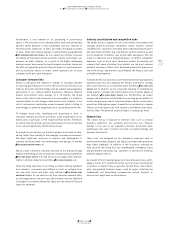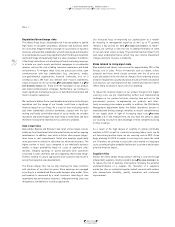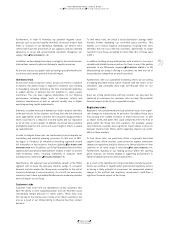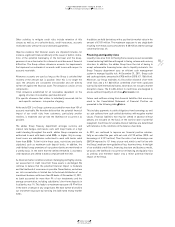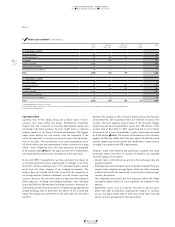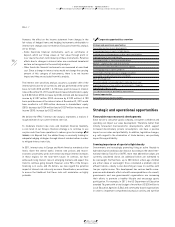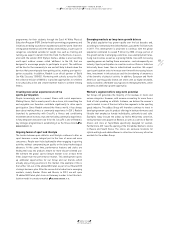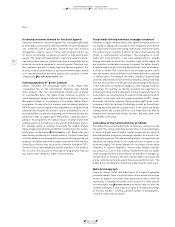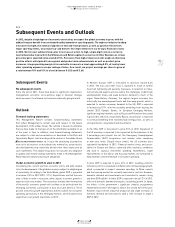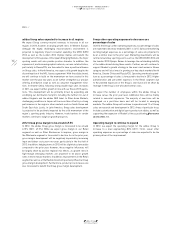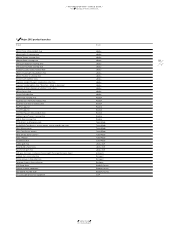Reebok 2011 Annual Report Download - page 163
Download and view the complete annual report
Please find page 163 of the 2011 Reebok annual report below. You can navigate through the pages in the report by either clicking on the pages listed below, or by using the keyword search tool below to find specific information within the annual report.
adidas Group
2011 Annual Report
GROUP MANAGEMENT REPORT – FINANCIAL REVIEW
159
2011
03.4 Risk and Opportunity Report Strategic and operational opportunities
programmes for their students through the Carol M. White Physical
Education Program (PEP). Similar health-promoting programmes and
initiatives are being launched or expanded around the world. Given the
strong global market position the adidas brand enjoys, in particular in
categories considered suitable for weight loss such as training and
running, we expect to benefit from this trend. Furthermore, in associ-
ation with the London 2012 Olympic Games, adidas is also launching
multi-sport outdoor venues called ’adiZones’ in the UK, that are
designed to encourage people to participate in sport. The adiZones
will be free for the community to use and will help to break down the
barriers that prevent people from getting active, making sport partici-
pation accessible. In addition, Reebok is an official partner of ’Build
Our Kids’ Success’ (’BOKS’). Partnering with schools across the USA,
the collective mission of BOKS is to provide opportunities for children
to be physically active and create healthier habits to achieve lifelong
fitness.
Creating new social experiences to drive
sports participation
People increasingly aim to connect fitness with social experience.
Making fitness, that is seen by most to be a chore, into something fun
and enjoyable can therefore contribute significantly to drive sports
participation. Since Reebok entered the fitness world, it has always
been about making fitness a community experience. In 2011, Reebok
launched its partnership with CrossFit, a fitness and conditioning
movement which involves a fun and motivating community experience,
to help empower everyone to be fit for life. CrossFit is one of Reebok’s
key strategic programmes in establishing it as the fitness brand
SEE
REEBOK STRATEGY, P. 78
.
Ongoing fusion of sport and lifestyle
The border between pure athletics and lifestyle continues to blur as
sport becomes a more integral part in the lives of more and more
consumers. People want to be fashionable when engaging in sporting
activities without compromising on quality or the latest technological
advances. At the same time, performance features and styles are
finding their way into products meant for more leisure-oriented use.
We estimate the global sports lifestyle market to be at least three
times larger than the performance market. This development opens
up additional opportunities for our Group and our brands, which
already enjoy strong positions in this market. One example of this is
the further roll-out of the adidas NEO label as part of our Route 2015
strategic business plan. After the successful introduction in emerging
markets, mainly Greater China and Russia, in 2012, we will open
10 adidas NEO label pilot stores in Germany in order to test this fast-
fashion model in a mature market
SEE ADIDAS STRATEGY, P. 72
.
Emerging markets as long-term growth drivers
The global population has grown rapidly over the last decades and,
according to estimates by the United Nations, passed the 7 billion mark
in 2011. This development is projected to continue, with the global
population estimated to exceed 9 billion by 2050. A large portion of
this growth will be in emerging economies. Low unemployment rates,
rising real incomes as well as a growing middle class with increasing
spending power are fuelling these economies – and subsequently our
industry. Sports participation in countries such as China or India has
historically been lower than in industrialised countries. We expect
sports participation rates to increase over time with increasing leisure
time, investment in infrastructure and the broadening of awareness
of the benefits of physical activity. In addition, European and North
American sporting goods brands are often seen as highly desirable,
easily accessible, affordable luxury goods in emerging markets, which
presents an additional growth opportunity.
Women’s segment offers long-term potential
Our Group still generates the majority of its revenues in men’s and
unisex categories. However, with women accounting for more than a
third of total spending on athletic footwear, we believe the women’s
sports market is one of the most attractive segments in the sporting
goods industry. The adidas Group will therefore continue to invest in
developing women-specific product offerings in both performance and
lifestyle that emphasise female individuality, authenticity and style.
Examples today include the adidas by Stella McCartney collection,
toning footwear and apparel at Reebok, as well as a series of Burner
drivers and irons at TaylorMade specifically designed for women.
Furthermore, 2011 saw the opening of the first adidas Women’s stores
in Russia and South Korea. The stores are exclusive locations for
stylish and high-end adidas Women’s collections in two very attractive
markets for the adidas Group.


